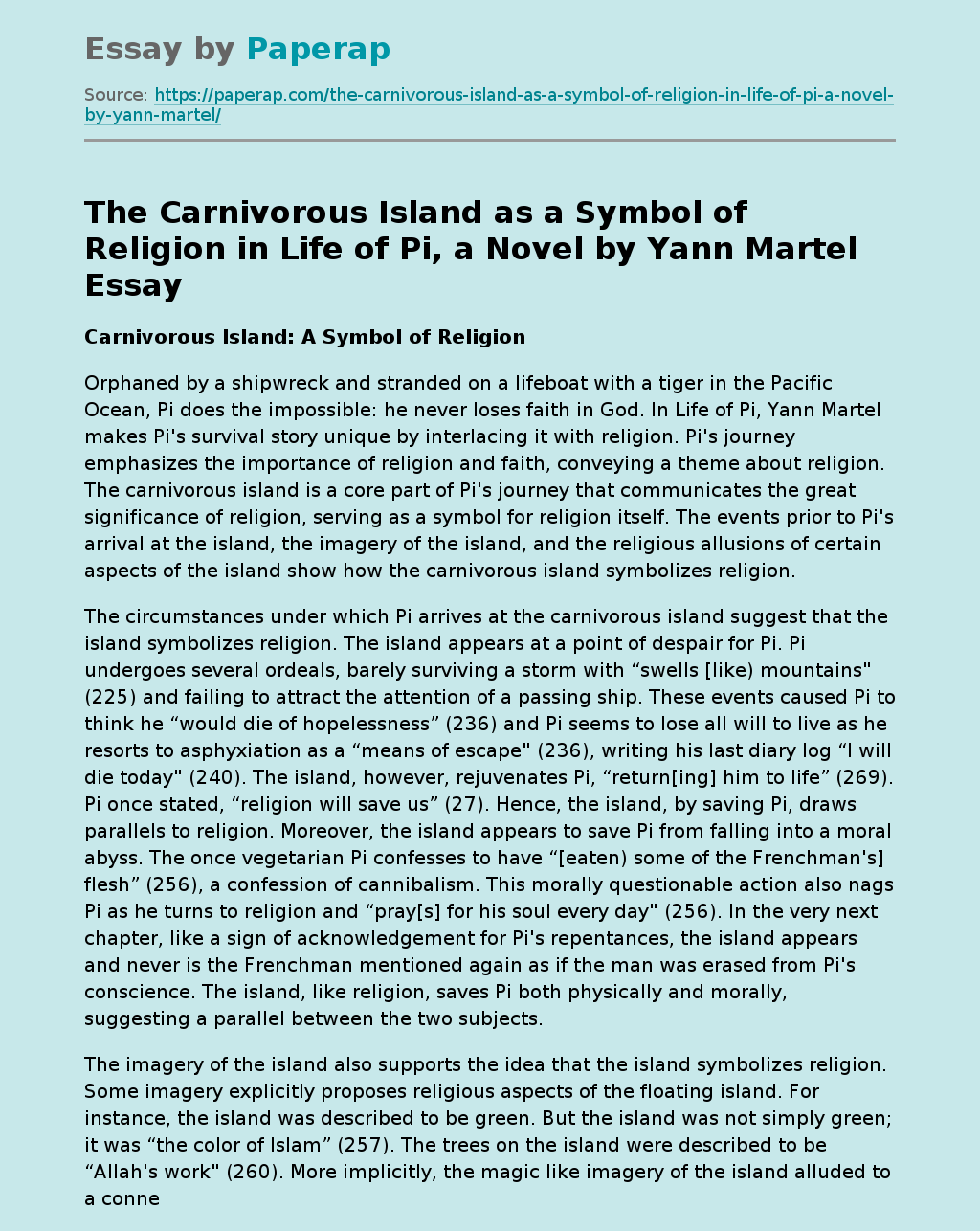Religious Symbol in Life of Pi: Carnivorous Island
Carnivorous Island: A Symbol of Religion
Orphaned by a shipwreck and stranded on a lifeboat with a tiger in the Pacific Ocean, Pi does the impossible: he never loses faith in God. In Life of Pi, Yann Martel makes Pi’s survival story unique by interlacing it with religion. Pi’s journey emphasizes the importance of religion and faith, conveying a theme about religion. The carnivorous island is a core part of Pi’s journey that communicates the great significance of religion, serving as a symbol for religion itself.
The events prior to Pi’s arrival at the island, the imagery of the island, and the religious allusions of certain aspects of the island show how the carnivorous island symbolizes religion.
The circumstances under which Pi arrives at the carnivorous island suggest that the island symbolizes religion. The island appears at a point of despair for Pi. Pi undergoes several ordeals, barely surviving a storm with “swells [like) mountains” (225) and failing to attract the attention of a passing ship.
These events caused Pi to think he “would die of hopelessness” (236) and Pi seems to lose all will to live as he resorts to asphyxiation as a “means of escape” (236), writing his last diary log “I will die today” (240). The island, however, rejuvenates Pi, “return[ing] him to life” (269). Pi once stated, “religion will save us” (27). Hence, the island, by saving Pi, draws parallels to religion. Moreover, the island appears to save Pi from falling into a moral abyss. The once vegetarian Pi confesses to have “[eaten) some of the Frenchman’s] flesh” (256), a confession of cannibalism.
This morally questionable action also nags Pi as he turns to religion and “pray[s] for his soul every day” (256). In the very next chapter, like a sign of acknowledgement for Pi’s repentances, the island appears and never is the Frenchman mentioned again as if the man was erased from Pi’s conscience. The island, like religion, saves Pi both physically and morally, suggesting a parallel between the two subjects.
The imagery of the island also supports the idea that the island symbolizes religion. Some imagery explicitly proposes religious aspects of the floating island. For instance, the island was described to be green. But the island was not simply green; it was “the color of Islam” (257). The trees on the island were described to be “Allah’s work” (260). More implicitly, the magic like imagery of the island alluded to a connection between the island and religion. The island was described as “a land with no soil”(257), a seeming oxymoron. The island’s fresh water ponds turned into “vast pots of acid that digested the fish” (282) by night like sorcery. Meerkats, an animal native to “the Kalahari Desert of Southern Africa” (265), were abundant on this island in the middle of the Pacific. All these images of the island are strange, supernatural, and mysterious, a quality that Pi uses to describe religion and how religious entities such as “Brahman and Atman relate precisely” (49). Sharing such mystic qualities with religion, the image of the carnivorous island reinforces the idea that the island symbolizes religion.
The island also has direct religious allusions that deepen the island’s connection with religion. The trees of the island are Biblical allusions to the tree of the Garden of Eden. The tree of the Garden of Eden is known as the Tree of Knowledge and it would not be a misnomer to name the trees of the island as trees of knowledge as well. The trees of the island provided Pi with critical knowledge: the island was carnivorous. Pi realized this fact only after “a complete human set [of teeth)” (281) in the flowers of a tree, a revelation that planted the “seed of [Pi’s] departure” (280). Like the Tree of Knowledge, the island’s trees bore fruits of knowledge as well. Another allusion can be made between sheep and meerkats. While sheep are often used in the Bible to refer to followers of Jesus and God, Martel uses meerkats. These meerkats resemble the sheep through their loyalty to their environment. Even in the face of Richard Parker, “the creatures seemed to feel no fear” (266) as if they had found an unnatural nirvana. Never abandoning the carnivorous island despite its many dangers, meerkats resemble devoted sheep of the Bible.
All in all, the island symbolizes religion as its mystical imagery, circumstances leading to its discovery, and religious allusions within the island show. Through such symbolism, the island amplifies the theme of religious importance as the island provides to be an essential turning point in Pi’s journey. This mirrors the importance of religion in Pi’s survival story. Martel suggests the high value of religion through Life of Pi but such as message does beg the question: is religion the only way to such spiritual salvation?
Religious Symbol in Life of Pi: Carnivorous Island. (2021, Dec 15). Retrieved from https://paperap.com/the-carnivorous-island-as-a-symbol-of-religion-in-life-of-pi-a-novel-by-yann-martel/

